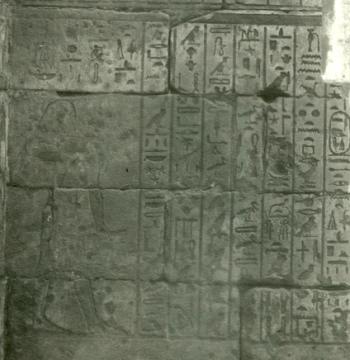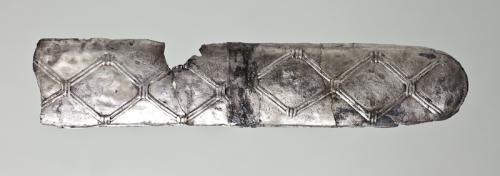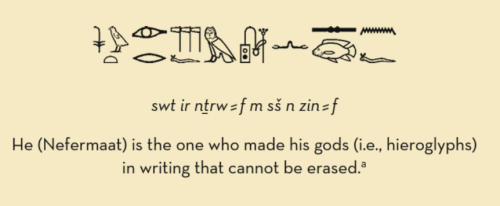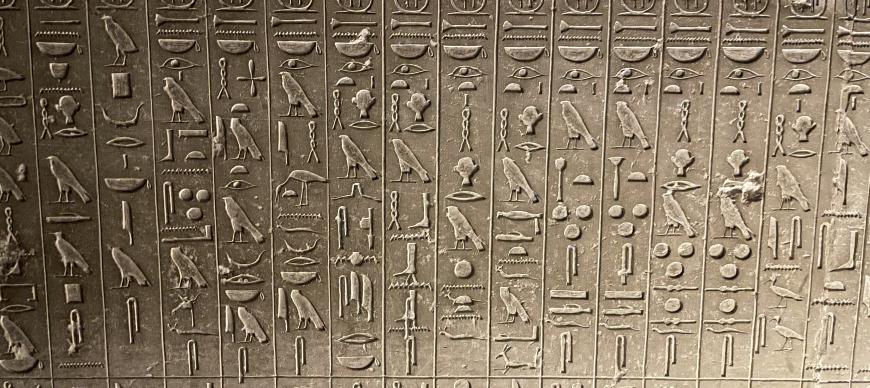Featured Class
Reading the Pyramid Texts: Introduction to Old Egyptian (8 weeks, Wednesdays, Wednesdays, June 28-August 23 (class does not meet August 16), 5-7pm Central (Chicago) Time on Zoom and recorded)
The Pyramid Texts were a corpus of mortuary rituals and other religious texts carved on the walls of the royal pyramids of the late Old Kingdom (~2375–2185 BCE). They represent the oldest religious literature in the world and form the foundation of the rich Egyptian mortuary traditions of the later Coffin Texts and Book of the Dead.
The Pyramid Texts are written using the hieroglyphic script and are in Old Egyptian, the name given by modern scholars to the language of Egypt in this period. In this class, we will use these fascinating texts as an introduction into both script, vocabulary, and grammar of Old Egyptian. We will start with short and grammatically simple Pyramid Text “utterances,” and will progress over the course of this 8-week class to longer and more complicated texts. Along the way, we will read and learn about early Egyptian religious beliefs and practices.
While previous knowledge of Egyptian languages will be helpful, it is not required for this course. Both beginner and intermediate students are welcome.

The Old Kingdom (Dynasties 3-6, ca. 2700-2200 BCE) is a well-known period in ancient Egypt because it is the time that pyramids are first built and also they appear on a massive scale. Starting with Djoser's step pyramid in Dynasty 3 (27th century BCE) and culminating with the famous Great Pyramids of Giza of Dynasty 4 (26th century BCE), the building of pyramids continued. The Pyramid Texts were originally meant to decorate the interior of royal tombs for the protection and transfiguration of the deceased. The placement of the texts inside royal burials which were in pyramids meant that they are today known as the "Pyramid Texts." The Pyramid Texts were inscribed in at least 10 royal burials that we know of from the Old Kingdom dating from both Dynasties V and VI, meaning that they come from after the time of the Great Pyramids although they are attested at Giza as well as Saqqara. After the end of the Old Kingdom, such texts are also found in non-royal contexts and are integrated into other texts such as the Coffin Texts and the Book of the Dead.

Pyramid Texts continued to be popular, particularly in the Third Intermediate Period, such as in the funerary chapel of God's Wife of Amun, Ameniridis I, daughter of Kashta of Nubia, who invaded Egypt. Her brother, Piye, controlled Egypt and established the Kushite Dynasty 25 there in ca. 750 BCE. Ameniridis' Pyramid Texts closely follow Old Kingdom examples, particularly those of Dynasty VI Pharaoh Pepi II and his wife Neith.

The Old Kingdom was not only a period of architectural innovation and when the first funerary texts that we have written down emerge in Egypt, it was also a time of trade connections with regions beyond Egypt. Although this silver scabbard dates to a much later period (4th-6th century CE) and comes from Nubia rather than Egypt, it is a good example of elite silver items that found their into tombs in places where silver was not local. Although in the past it was believed that Old Kingdom silver objects came from Anatolia, new evidence from the jewelry of Khufu's mother Hetepheres has shown that some silver came also from the Aegean pointing to further trade between various regions in the Early Bronze Age. The Egyptians also sent expeditions to Nubia and the Sinai in this period as well as Yam, which is likely located in Chad.

The Old Kingdom is also a period of linguistic innovation with the appearance of Old Egyptian. Old Egyptian is the earliest phase of the ancient Egyptian language where we have complete sentences, as prior to this the language consisted of labels, proper names, etc. Therefore, texts such as the Pyramid Texts and others from this period provide us with considerable information about the Old Kingdom and its religious, historical, and cultural contexts.


